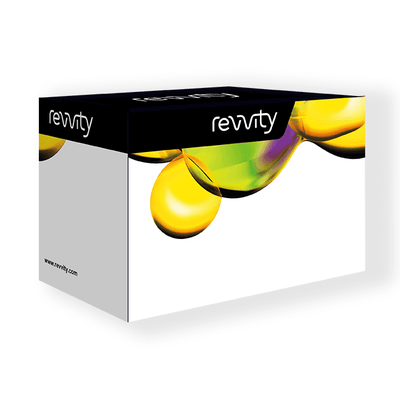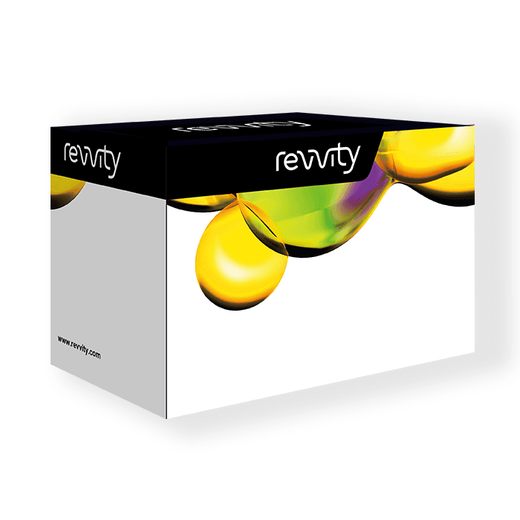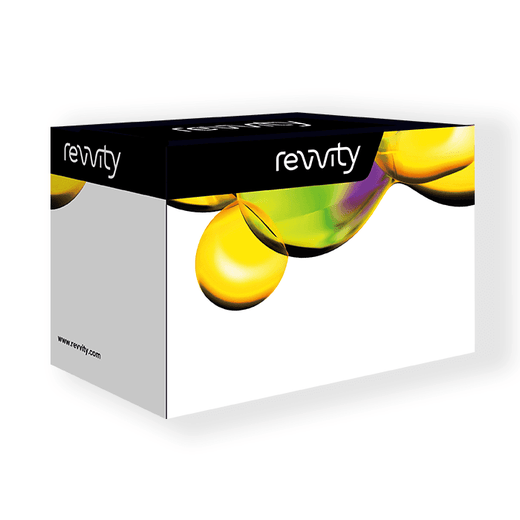

HTRF Human Phospho-SYK (Tyr525/526) Detection Kit, 10,000 Assay Points


HTRF Human Phospho-SYK (Tyr525/526) Detection Kit, 10,000 Assay Points






This HTRF kit enables the cell-based quantitative detection of phosphorylated SYK (Spleen Tyrosine Kinase) at Tyr525/526, as a readout of multiple adaptive and innate immune cell surface receptors.
For research use only. Not for use in diagnostic procedures. All products to be used in accordance with applicable laws and regulations including without limitation, consumption and disposal requirements under European REACH regulations (EC 1907/2006).
| Feature | Specification |
|---|---|
| Application | Cell Signaling |
| Sample Volume | 16 µL |
This HTRF kit enables the cell-based quantitative detection of phosphorylated SYK (Spleen Tyrosine Kinase) at Tyr525/526, as a readout of multiple adaptive and innate immune cell surface receptors.
For research use only. Not for use in diagnostic procedures. All products to be used in accordance with applicable laws and regulations including without limitation, consumption and disposal requirements under European REACH regulations (EC 1907/2006).



HTRF Human Phospho-SYK (Tyr525/526) Detection Kit, 10,000 Assay Points



HTRF Human Phospho-SYK (Tyr525/526) Detection Kit, 10,000 Assay Points



Product information
Overview
This HTRF cell-based assay conveniently and accurately detects phosphorylated SYK at Tyr525/526.
SYK (Spleen Tyrosine Kinase) is a cytoplasmic tyrosine/serine kinase which plays a crucial role in signal transduction, especially in immune cells such as B cells, macrophages, microglia (brain-resident macrophages), neutrophils and mast cells. Upon cell stimulation, SYK interacts with the cytoplasmic domains of activated immune receptors and binds to the specific phosphorylated receptor motifs (called "p-ITAMs"), leading to its activation by auto-phosphorylation of its catalytic domain at Tyr525/526.
SYK phosphorylation is a readout of key inflammatory pathways such as BCR, FcR and TREM2 signaling pathways that are altered in various pathologies such as auto-immune diseases, neurodegeneration, cancers and allergic disorders.
Specifications
| Application |
Cell Signaling
|
|---|---|
| Brand |
HTRF
|
| Detection Modality |
HTRF
|
| Lysis Buffer Compatibility |
Lysis Buffer 3
Lysis Buffer 4
Lysis Buffer 5
|
| Molecular Modification |
Phosphorylation
|
| Product Group |
Kit
|
| Sample Volume |
16 µL
|
| Shipping Conditions |
Shipped in Dry Ice
|
| Target Class |
Phosphoproteins
|
| Target Species |
Human
|
| Technology |
TR-FRET
|
| Therapeutic Area |
Neuroscience
Oncology & Inflammation
|
| Unit Size |
10,000 Assay Points
|
Video gallery

HTRF Human Phospho-SYK (Tyr525/526) Detection Kit, 10,000 Assay Points

HTRF Human Phospho-SYK (Tyr525/526) Detection Kit, 10,000 Assay Points

How it works
Phospho-SYK (Tyr525/526) assay principle
The Phospho-SYK (Tyr525/526) assay measures SYK when phosphorylated at Tyr525/526. Unlike Western Blot, the assay is entirely plate-based and does not require gels, electrophoresis, or transfer. The assay uses 2 antibodies, one labeled with a donor fluorophore and the other with an acceptor. The first antibody is selected for its specific binding to the phosphorylated motif on the protein, the second for its ability to recognize the protein independently of its phosphorylation state. Protein phosphorylation enables an immune-complex formation involving both labeled antibodies, and which brings the donor fluorophore into close proximity to the acceptor, thereby generating a FRET signal. Its intensity is directly proportional to the concentration of phosphorylated protein present in the sample, and provides a means of assessing the protein's phosphorylation state under a no-wash assay format.

Phospho-SYK (Tyr525/526) two-plate assay protocol
The two-plate protocol involves culturing cells in a 96-well plate before lysis, then transferring lysates to a 384-well low volume detection plate before the addition of Phospho-SYK (Tyr525/526) HTRF detection reagents. This protocol enables the cells' viability and confluence to be monitored.

Phospho-SYK (Tyr525/526) one-plate assay protocol
Detection of Phosphorylated SYK (Tyr525/526) with HTRF reagents can be performed in a single plate used for culturing, stimulation, and lysis. No washing steps are required. This HTS designed protocol enables miniaturization while maintaining robust HTRF quality.

Assay validation
TREM2 pathway activation in iPSC-macrophages
Parental (BIONi010-C, EBiSC #66540023) and TREM2 KO (BIONi010-C-17, EBiSC #66540632) human iPSC-derived macrophages, differentiated as described in Van Wilgenburg et al., 2013 (1), were plated in a 96-well plate at 40,000 cells/well. After 8 days of culture, cells were treated for 5 minutes with 5 µg/mL of an anti-TREM2 antibody (known to activate the receptor) or with the corresponding isotype control (Goat IgG antibody). After medium removal, cells were lyzed with 50 µL of supplemented lysis buffer #3 (1X) for 30 minutes at RT under gentle shaking, and 16 µL of cell lysate were then transferred into a 384-well low volume white microplate before the addition of 4 µL of the HTRF Phospho-SYK (Tyr525/526) detection reagents. The HTRF signal was recorded after an overnight incubation.
As expected, the anti-TREM2 antibody induced an activation of the TREM2 pathway in the parental iPSC-macrophages, as highlighted by the increase in SYK phosphorylation at Tyr525/526, while the treatment did not modulate the phosphorylation status of the protein in the TREM2 KO cell line*.
*These data were obtained in collaboration with the Alzheimer’s Research UK Oxford Drug Discovery Institute (ODDI).
(1) Van Wilgenburg et al., Efficient, long term production of monocyte derived macrophages from human pluripotent stem cells under partly defined and fully defined conditions; 2013; PLOS One; Vol. 8, Issue 8.

SYK activation in anti-IgM-stimulated Ramos B cells
The human B cell lymphoma Ramos cell line was seeded in a half 96-well culture-treated plate at 100,000 cells/well in 20 µL FBS-free culture medium. After an overnight incubation at 37 °C, 5% CO2, cells were stimulated with 10 µL of increasing concentrations of an anti-human IgM antibody for 10 minutes, and then lyzed with 10 µL of supplemented lysis buffer #3 (4X) for 30 minutes at RT under gentle shaking. For the detection step, 16 µL of cell lysate were transferred into a 384-well low volume white microplate and 4 µL of the HTRF Phospho-SYK (Tyr525/526) or Total-SYK detection reagents were added. The HTRF signal was recorded after an overnight incubation.
The anti-human IgM antibody induced a dose-dependent increase in SYK phosphorylation at Tyr525/526 without changing the expression level of the protein, demonstrating the activation of the BCR complex at the cell surface.

SYK inhibition in macrophage-differentiated THP-1 cells treated with P505-15
The human monocytic THP-1 cell line was seeded in a 96-well culture-treated plate at 200,000 cells/well and differentiated into macrophages by incubation with 100 ng/mL PMA for 24h at 37 °C, 5% CO2. After differentiation, cells were first treated with increasing doses of the SYK inhibitor P505-15 for 1h, and then with 250 µM pervanadate for 10 minutes. After treatment, cells were lyzed with 50 µL of supplemented lysis buffer #3 (1X) for 30 minutes at RT under gentle shaking, and 16 µL of cell lysate were transferred into a 384-well low volume white microplate before the addition of 4 µL of the HTRF Phospho-SYK (Tyr525/526) or Total-SYK detection reagents. The HTRF signal was recorded after an overnight incubation.
As expected, the SYK inhibitor P505-15 induced a dose-dependent decrease in SYK phosphorylation at Tyr525/526, while the expression level of the kinase was not modulated by the treatment.

HTRF phospho-SYK (Tyr525/526) assay compared to western blot
The human B cell lymphoma Ramos cell line was cultured in a T175 flask in complete culture medium for 48h at 37 °C, 5% CO2. After centrifugation, pelleted cells were stimulated with 20 µg/mL of an anti-human IgM antibody for 10 minutes. The following an additional centrifugation step, cells were lyzed with 10 mL of supplemented lysis buffer #3 (1X) for 30 minutes at RT under gentle shaking.
Serial dilutions of the cell lysate were performed using supplemented lysis buffer, and 16 µL of each dilution were transferred into a low volume white microplate before the addition of 4 µL of HTRF phospho-SYK (Tyr525/526) detection reagents. Equal amounts of lysates were used for a side by side comparison between HTRF and Western Blot.
Using the HTRF phospho-SYK (Tyr525/526) assay, 1,000 cells/well were enough to detect a significant signal, while 4,000 cells were needed to obtain a minimal chemiluminescent signal using Western Blot. Therefore in these conditions, the HTRF phospho-SYK assay was 4 times more sensitive than the Western Blot technique.

Simplified pathway
Simplified pathway of SYK signaling
SYK (Spleen Tyrosine Kinase) is a cytoplasmic tyrosine/serine kinase which plays a crucial role in signal transduction, especially in immune cells such as B cells and microglia (brain-resident macrophages).
Upon stimulation of B cells or TREM2/DAP12 receptor complexes, SYK interacts with the cytoplasmic domains of CD79 subunits or DAP12 respectively by binding to their specific phosphorylated receptor motifs, called 'p-ITAMs'. This leads to SYK activation by auto-phosphorylation of its catalytic domain at Tyr525/526. SYK in turn phosphorylates downstream substrates such as BTK, triggering the activation of multiple signaling pathways and cellular responses, including cell activation, proliferation, and survival.

Resources
Are you looking for resources, click on the resource type to explore further.
Get a useful overview of today’s immunity knowledge with this booklet
Immunity is a collection of complex processes involving...
This guide provides you an overview of HTRF applications in several therapeutic areas.
Advance your autoimmune disease research and benefit from Revvity broad offering of reagent technologies


How can we help you?
We are here to answer your questions.






























